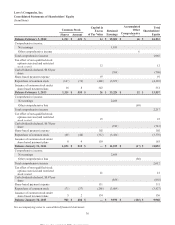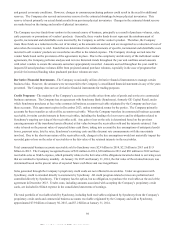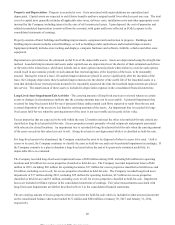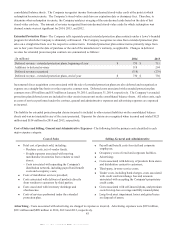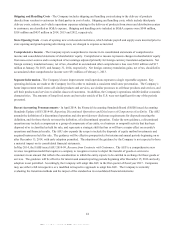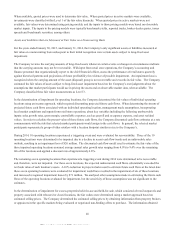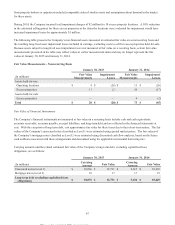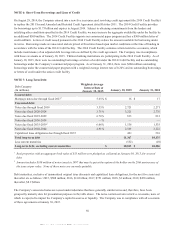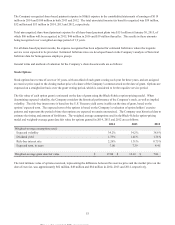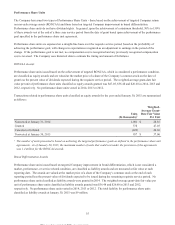Lowe's 2014 Annual Report Download - page 56
Download and view the complete annual report
Please find page 56 of the 2014 Lowe's annual report below. You can navigate through the pages in the report by either clicking on the pages listed below, or by using the keyword search tool below to find specific information within the annual report.When available, quoted prices were used to determine fair value. When quoted prices in active markets were available,
investments were classified within Level 1 of the fair value hierarchy. When quoted prices in active markets were not
available, fair values were determined using pricing models, and the inputs to those pricing models were based on observable
market inputs. The inputs to the pricing models were typically benchmark yields, reported trades, broker-dealer quotes, issuer
spreads and benchmark securities, among others.
Assets and Liabilities that are Measured at Fair Value on a Nonrecurring Basis
For the years ended January 30, 2015, and January 31, 2014, the Company’s only significant assets or liabilities measured at
fair value on a nonrecurring basis subsequent to their initial recognition were certain assets subject to long-lived asset
impairment.
The Company reviews the carrying amounts of long-lived assets whenever certain events or changes in circumstances indicate
that the carrying amounts may not be recoverable. With input from retail store operations, the Company’s accounting and
finance personnel that organizationally report to the chief financial officer, assess the performance of retail stores quarterly
against historical patterns and projections of future profitability for evidence of possible impairment. An impairment loss is
recognized when the carrying amount of the asset (disposal) group is not recoverable and exceeds its fair value. The Company
estimated the fair values of assets subject to long-lived asset impairment based on the Company’s own judgments about the
assumptions that market participants would use in pricing the assets and on observable market data, when available. The
Company classified these fair value measurements as Level 3.
In the determination of impairment for operating locations, the Company determined the fair values of individual operating
locations using an income approach, which required discounting projected future cash flows. When determining the stream of
projected future cash flows associated with an individual operating location, management made assumptions, incorporating
local market conditions and inputs from retail store operations, about key variables including the following unobservable
inputs: sales growth rates, gross margin, controllable expenses, such as payroll and occupancy expense, and asset residual
values. In order to calculate the present value of those future cash flows, the Company discounted cash flow estimates at a rate
commensurate with the risk that selected market participants would assign to the cash flows. In general, the selected market
participants represented a group of other retailers with a location footprint similar in size to the Company’s.
During 2014, 10 operating locations experienced a triggering event and were evaluated for recoverability. Three of the 10
operating locations were determined to be impaired due to a decline in recent cash flow trends and an unfavorable sales
outlook, resulting in an impairment loss of $26 million. The discounted cash flow model used to estimate the fair value of the
three impaired operating locations assumed average annual sales growth rates ranging from 4.0% to 9.4% over the remaining
life of the locations and applied a discount rate of approximately 6.6%.
The remaining seven operating locations that experienced a triggering event during 2014 were determined to be recoverable
and, therefore, were not impaired. For these seven locations, the expected undiscounted cash flows substantially exceeded the
net book value of each location’s assets. A 10% reduction in projected sales used to estimate future cash flows at the latest date
these seven operating locations were evaluated for impairment would have resulted in the impairment of six of these locations
and increased recognized impairment losses by $71 million. We analyzed other assumptions made in estimating the future cash
flows of the operating locations evaluated for impairment, but the sensitivity of those assumptions was not significant to the
estimates.
In the determination of impairment for excess properties held-for-use and held-for-sale, which consisted of retail outparcels and
property associated with relocated or closed locations, the fair values were determined using a market approach based on
estimated selling prices. The Company determined the estimated selling prices by obtaining information from property brokers
or appraisers in the specific markets being evaluated or negotiated non-binding offers to purchase. The information obtained
46
This proof is printed at 96% of original size
This line represents final trim and will not print


